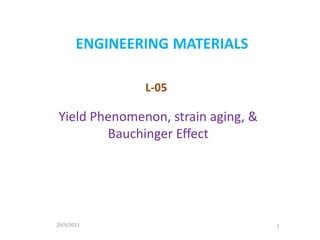
L 05
- 1. ENGINEERINGMATERIALS L-05 Yield Phenomenon, strain aging, & Bauchinger Effect 29/9/2011 1
- 2. Yield Phenomenon and Twinning in α-Iron IRON containing small amounts of 1-carbon and 2-nitrogenexhibits a peculiar relationship between 1-stress and 2-strainwhich appears in 1-different formsat 2-different temperatures; it shows the 1-yield phenomenon at room temperature, 2-blue brittleness at temperatures in the range 200–400° C., and 3-twinning at the temperature of liquid air. The part played by the carbon and nitrogen in the yield phenomenon has been explained by a recent theory according to which certain foreign atoms in the metal collect preferentially at dislocations. 2 29/9/2011
- 3. Yield Phenomenon Blue brittleness occurs when the temperature and strain-rate* are such that 1-strain ageing can occur during the time needed for a 2-Lüders band to travel along the specimen. This causes repeated yielding to take place. * strain-rate:- rate of change in strain with respect to time 29/9/2011 3
- 4. Blue Brittleness Upon heating some plain carbon and alloy steels-not necessarily those that have been quenched to martensite or bainite-can exhibit both an increase in strength and a substantial decrease in ductility/ impact strength. In this low temperature range (204-316°C), the blue heat range, we call this effect blue brittleness. Blue Brittleness is a strain aging mechanism that occurs in this blue heat temperature range. 4 29/9/2011
- 5. Yield Point Phenomenon During tensile deformation materials initially deform elastically and the yield point marks the onset of plastic deformation. For most materials the transition from elastic to plastic deformation is gradual and hence do not exhibit a sharp transition point. Such materials show engineering stress versus engineering-strain curves . However, in some cases (and more specifically in the case of mild steel) the transition is a sharp one and is exhibited in what has been termed as the yield point phenomenon. A phenomenon observed when low carbon mild steel has been subjected to a certain amount of cold deformation and is then allowed to age for a period. شروعات کو 29/9/2011 منتقلی 5
- 6. Lüders band First reported by Guillaume Piobert and W. Lüders, Lüders bands, also known as "slip bands" or "stretcher-strain marks," are localized bands of plastic deformation in metals experiencing tensile stresses, common to low-carbon steels and certain Al-Mg alloys The mechanism that stimulates their appearance is known as "dynamic strain aging," or the pinning of dislocations by interstitial atoms (in steels, typically carbon and nitrogen), around which "atmospheres" or "zones" naturally congregate. 29/9/2011 6 جمع
- 7. Lüders band As internal stresses tend to be highest at the shoulders of tensile test specimens, band formation is favored in those areas. However, the formation of Lüders bands depends primarily on the microscopic (i.e. average grain size and crystal structure, if applicable) and macroscopic geometries of the material. For example, a tensile-tested steel bar with a square cross-section tends to develop comparatively more bands than would a bar of identical composition having a circular cross-section.) The formation of a Lüders band is preceded by a yield point and a drop in the flow stress. 29/9/2011 7
- 8. Lüders band Then the band appears as a localized event of a single band between plastically deformed and undeformed material that moves with the constant cross head velocity. The Lüders Band usually starts at one end of the specimen and propagates toward the other end. The visible front on the material usually makes a well-defined angle typically 50-55º from the specimen axis as it moves down the sample. 8 29/9/2011
- 9. Lüders band During the propagation of the band the nominal stress–strain curve is flat. After the band has passed through the material the deformation proceeds uniformly with positive strain hardening . Sometimes Lüders band transition into the Portevin–Le Chatelier effect while changing temperature or strain rate, this implies these are related phenomena Lüders bands are known as a strain softening instability. 29/9/2011 9 عدم استحکام
- 10. Bauschinger effect TheBauschingereffect refers to a property of materials where the material's stress/strain characteristics change as a result of the microscopic stress distribution of the material. For example, an increase in tensile yield strength occurs at the expense of compressive yield strength. The Bauschinger effect is named after the German engineer Johann Bauschinger. While more tensile cold working increases the tensile yield strength, the local initial compressive yield strength after tensile cold working is actually reduced. 10 03/10/2011
- 11. Bauschinger effect The greater the tensile cold working, the lower the compressive yield strength. The Bauschinger effect is normally associated with conditions where the yield strength of a metal decreases when the direction of strain is changed. It is a general phenomenon found in most polycrystalline metals. basic mechanism for the Bauschinger effect is related to the dislocation structure in the cold worked metal. 03/10/2011 11
- 12. Bauschinger effect As deformation occurs, the dislocations will accumulate at barriers and produce dislocation pile-ups and tangles. Based on the cold work structure, two types of mechanisms are generally used to explain the Bauschinger effect. First, local back stresses may be present in the material, which assist the movement of dislocations in the reverse direction. Thus, the dislocations can move easily in the reverse direction and the yield strength of the metal is lower. 12 03/10/2011
- 13. Bauschinger effect The pile-up of dislocations at grain boundaries and Orowan loops around strong precipitates are two main sources of these back stresses. Second, when the strain direction is reversed, dislocations of the opposite sign can be produced from the same source that produced the slip-causing dislocations in the initial direction. with opposite signs can attract and annihilate each other. 13 03/10/2011
- 14. Bauschinger effect Since strain hardening is related to an increased dislocation density, reducing the number of dislocations reduces strength. The net result is that the yield strength for strain in the opposite direction is less than it would be if the strain had continued in the initial direction. 03/10/2011 14
